Posted by
Mordy Oberstein
The conception of a pay-to-play Google My Business (GMB) recently hit DEFCON 1. While many in the industry (myself included) have considered the notion of Google asking small businesses to open up their wallets to be inevitable for some time now, recent developments have blown the conversation wide open. As an uncovered Google survey clearly implies, monetization of Google’s local business listings could very well be on its way!
What I’d like to do is jump into the Delorean, push the pedal to 88 miles per hour, and put the pieces of this puzzle together. Let’s take a look back at how a heck of a lot of Google’s updates to local features over the past year (or so) all point towards GMB monetization!
Where Google’s Local Listing Monetization Began in Earnest
It’s not easy to pinpoint the one moment where local listing monetization became “a thing.” I’m sure different people will have different opinions. However, since none of these folks are writing this post, I can only offer you my opinion, and for me, the idea of Google thinking of its local features in terms of revenue began in earnest with the prolific changes to the hotel Local Panel.
Let’s go back to 2017.
The summer/fall of 2017 saw Google take an incredible leap forward in regards to both the depth and functionality of the Local Knowledge Panel for hotel listings. Interestingly, the hotel Local Panel was updated alongside Google Flights, with both receiving similar upgrades simultaneously. This is important to note because Google Flights is one of the search engine’s more revenue driven SERP features, as airlines shell out a referral fee for bookings made via the SERP.
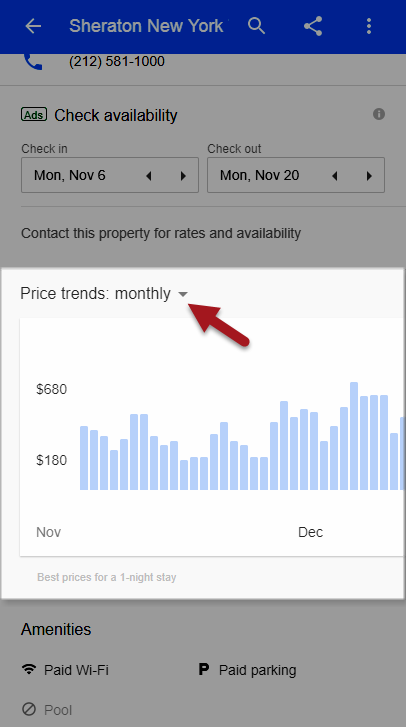
In other words, one way to look at the growing relationship between the two features is via the lens of practicality. Flights and hotels are part of the same travel equation. That said, and that being true, there is another perspective to consider, that of revenue. Google Flights and the hotel Local Panel are natural siblings at the development level due to their unique revenue possibilities, with the hotel panel offering a plethora of ads from the bookings sites as well as a paid relationship between the featured hotel and Google as well.
Simply, the pairing of Google Flights and the hotel Local Panel’s development hinges on similar revenue paradigms. Thus, when Google went all-in on developing the capabilities within both, it was for the sake of revenue. In my mind, it marked a clear shift in thought. No longer was revenue to be dependent on ads alone (more on this later). Now Google’s revenue strategy was to be heavily linked to local SERP features.
Just to highlight this, over the past year and a half we’ve seen Google bring price insights to hotel listings (which also brought competition to a business’s Local Panel), revamp the hotel Local Pack entirely, and create an independent hotel booking website of its own!
But where has this local SERP feature focus led us?
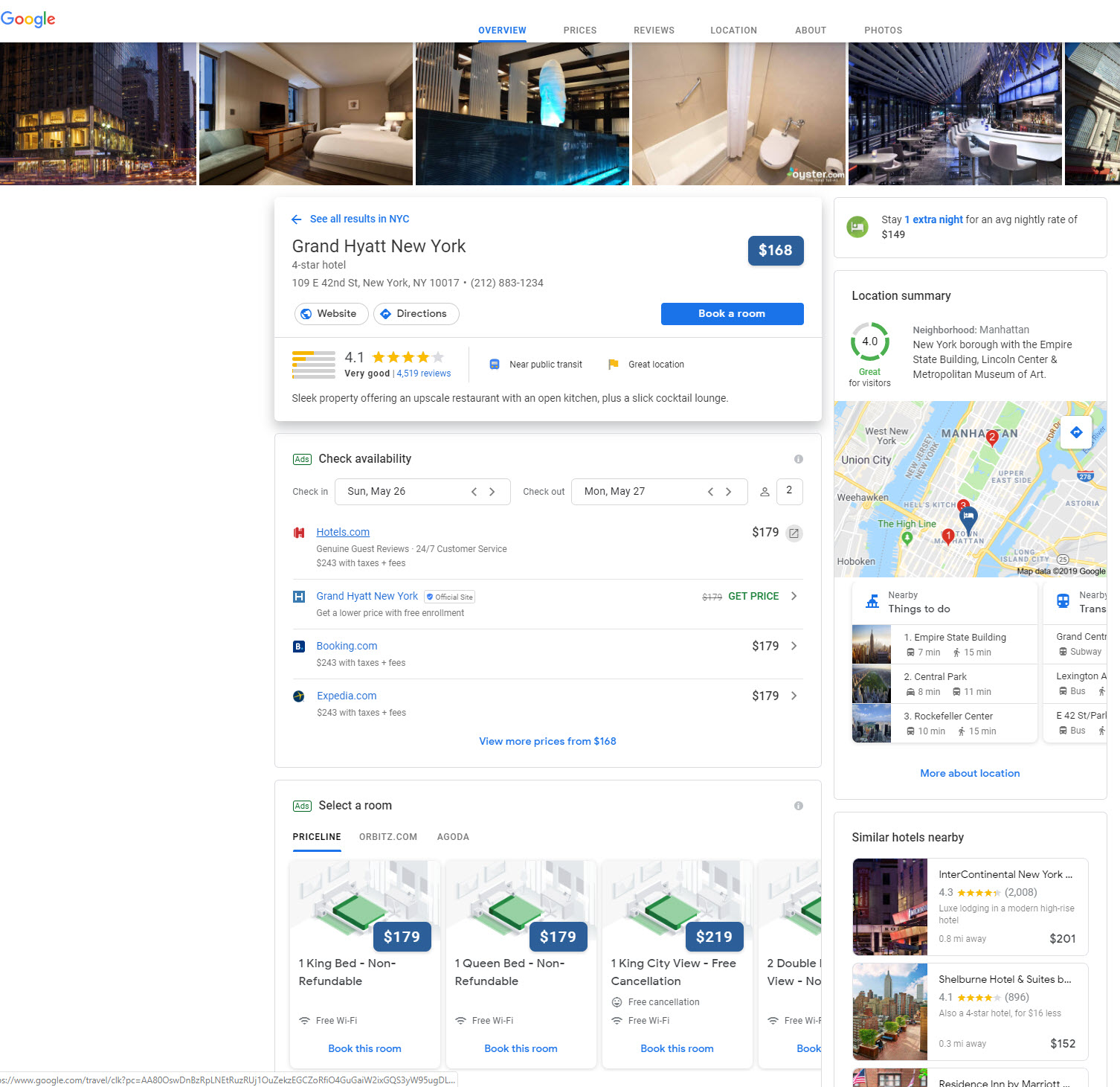
The Road to Google My Business Monetization is Paved in Local Feature Intentions
While the overhaul of Google’s hotel listings ushered in a new era in Google’s revenue strategy, it doesn’t directly lead to the plausibility of a pay to play Google My Business paradigm. Rather, as I see it, it was the initial catalyst for the changes and updates to Google’s local search features that we’ve seen over the past year or so. It is these updates to the local features that have put us on a collision course with a monetized version of GMB.
Observe.
The Evolution of Google Posts Points Towards Local Listing Monetization
I’ve been banging my head against a wall as to why Google has gone gaga over Google Posts. It just didn’t add up. Sure, there were the usual suspects: Google wants to create a more Google-centric environment and Google wants to rebuild its social media foothold (especially with Google+ shutting its doors). Those are good answers, but in the pit of my stomach, I felt unsatisfied. Until now.
Before I get into how I think Google Posts factors into the GMB monetization equation, it’s worthwhile to see how the local feature has evolved. Here are some of the more notable tests and changes we’ve seen over the past year or so (in no particular order):
1) Google Posts Replicated in Local SERP Features: Upping the importance of the feature, there have been instances where a Google Post has been cloned and placed within other local SERP features (i.e., the Local Pack, etc.). This means that one posting can have its impact multiplied without any further action on the part of the creator.
2) Anchor Text for Google Posts: In January 2019, Google combined the visibility of Google Posts with the power of directing users to carefully curated content accessed via anchor text. That is, Google made it possible for verified accounts to use anchor text to direct users to specific pages (as opposed to plopping a clunky URL into the post).
3) Product & Offer Posts: Two new types of Google Posts were made available in June of 2018; product and offer posts. The importance of being able to showcase products and offers within Google Posts vis-a-vis its impact on the feature’s relevance can’t be overstated. The new formats, in effect, took Google Posts from being “quaint” to being an integral part of a local business’s marketing plan.
4) More Characters Made Available to Post Creators: Google Posts, aside from having a short shelf life (7 days in most cases), had an even shorter content berth of between just 100 – 300 characters. No more! Now Posts can contain up to 1,500 characters! Of course, having a considerable content limit makes the feature all the more viable as it means creators can produce engaging and effective posts.
5) Additional CTAs Added to Google Posts: As time has gone on, Google has added more and more CTAs to Google Posts. For example, back in July of 2018, Google gave Posts a ‘call now’ CTA. The wider the CTA library, the more attractive the feature becomes to local businesses.
6) Featured Customer Reviews in Google Posts: I’ve saved the best for last – customer reviews in Google Posts! Available as of April 2019, being able to create a post that prominently displays your best customer reviews is a highly attractive option for any local business. More than that, the addition of the ability to showcase reviews in Google Posts takes its applicability to all new levels.
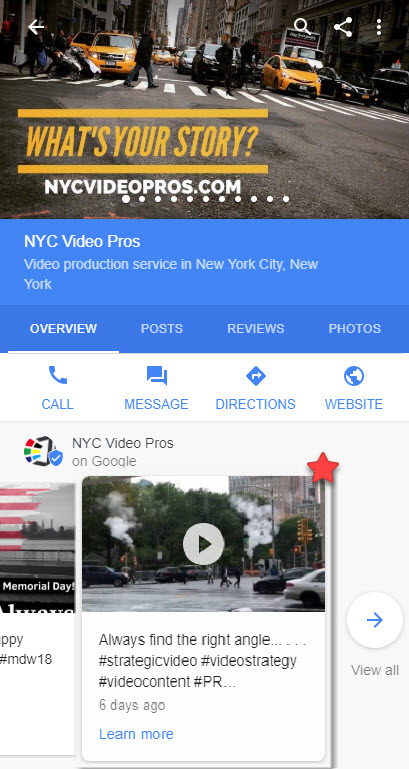
In May of 2018, Google gave local businesses the ability to add video content to Google Posts
Why am I telling you all of this? Easy. There’s one common theme to all of the above-listed updates to Google Posts. There’s one overarching impact… Google Posts have morphed into a crucial part of a local marketing strategy. All of these changes make Google Posts far more essential to your average business owner than the feature was just a year ago.
Think about it. A year ago your CTA options were limited, your very content was severely hampered by a drastically small character limit. Just a year ago, you could not feature your products nor showcase your offers. How much more relevant does this make Google Posts to your average business? Far more!
Now imagine if Google took all of this away. Imagine if Google took the ability to create posts away from businesses. What would the fallout be? Considerable for many I would think.
What if, Google said you could retain your ability to create posts… but for a cost? Would you consider it? Most likely (all things being equal). Would you have considered paying for Google Posts with a character limit of 300 characters? Without a wide library of CTAs? Without the ability to present offers or feature customer reviews?
Now that is a satisfying answer to why Google has beefed-up Google Posts for the better part of the last year and a half!
Reserve with Google as an Integral Piece of Google My Business Monetization
What if I could replicate the above analysis on Google Posts and apply it to Reserve with Google? Wouldn’t that help construct a purposeful pattern of Google priming GMB for monetization by bolstering its local SERP features?
Let’s have it at then.
The Rapid Growth of ‘Reserve with Google’ & its Monetization Implications
Since October 2017, Google has been offering users the ability to book an appointment and make a reservation directly through the business listing. It’s called Reserve with Google and since its fall of 2017 launch, it has spread like wildfire.
Initially, the service was applicable to but a few business categories (appointments at yoga studios being one of them). However, since August 2018, we’ve seen Google bring its in-house reservation destination to an increasing number of business categories on multiple occasions. Now the program applies to everything from guitar lessons to eateries!
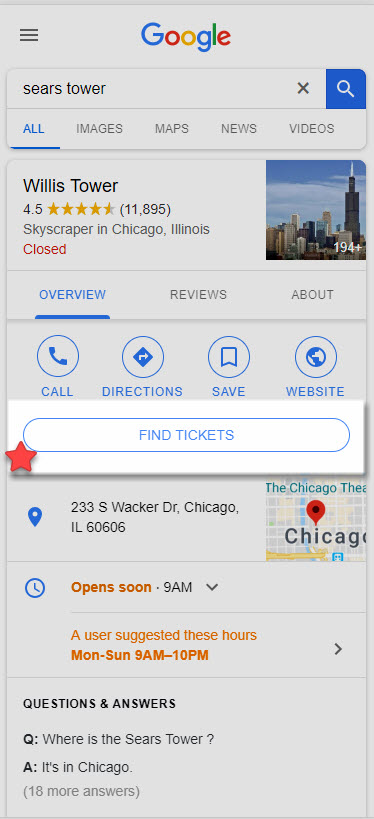
The Reserve with Google program has expanded to include reserving tickets to local attractions
That’s the least of it because, in the fall of 2018, Reserve with Google entered the Local Pack. This is a huge deal. As local SEO expert Sergey Alakov noted during a podcast interview I did with him in February 2019, Reserve with Google in the Local Pack stimulates its adoption.
How so?
Here’s where it all comes together. Prior to its insertion into the Local Pack, a user had no way of knowing if a business offered expedited bookings via the program or not. That is, unless they did a manual check by digging into multiple business listings. There was no competitive advantage in terms of a user deciding to go with one business over the other due to the Reserve with Google program.
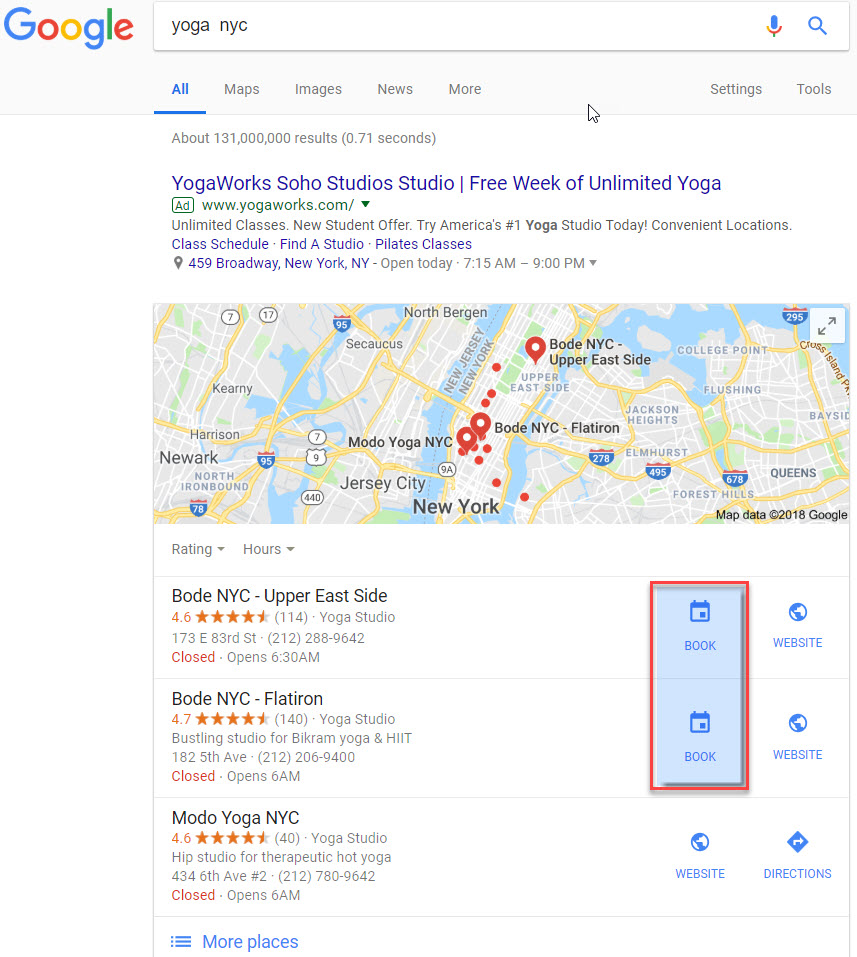
The Local Pack indicating that the top two listings are a part of the Reserve with Google program
With the scheduling icon now showing up in the Local Pack, you can burn that paradigm and then throw its ashes out the window and into a stormy sea. Now, users can compare local listings in terms of available booking efficiency at the top level of a local business quest (i.e., the initial search query). Meaning, if one business shows up in the Local Pack with the Reserve with Google icon and one does not, the former becomes far more attractive to the user.
This in turn ups the ante a bit. Now small businesses need to be concerned with their competition’s adoption of Reserve with Google. Once any given competitor makes the leap into the world of on-SERP reservations, the pressure is on for other related listings to follow suit.
This is a drum I’ve been beating on for a long time now. The air around Reserve with Google has been wafting with the aroma of businesses being charged to use it since its inception. I thought a referral fee system would be implemented. However, with the program being singled out in the “GMB monetization survey,” it seems Google wants to go in the direction of asking for a flat fee to enter.
The insertion of the program within the Local Pack, along with SERP bookings being relevant to a slew of business categories, is the very thing that allows Google to go with Reserve with Google monetization. If a business is now put in a position where they need the feature to stay competitive, it’s not crazy to assert they will pay to play!
Thus, the very thing Google did with Posts applies to Reserve with Google. Create an environment where businesses need and rely on the features… and then charge for them.
Product Listings Inside SERP Features: The Nail in the Coffin that Is Free Google Business Listings
I’d like to discuss the prevalence of products being placed within Google’s local SERP features. At this point, you can probably guess what I’m going to do. Accordingly, let’s have a look and see how Google has fostered deep reliance on its local SERP features by revving up product placements within them.
It goes to reason that once a local business needs Google’s SERP features to get their products out there all monetization options are game. Putting products in front of potential customers is the jugular of a local business’s SERP vitality.
Over the past year to year and a half, there has been a concentrated effort to fill local SERP features with accessibility to a business’s products. We’ve already seen this with products and offers within Google Posts. Here are but a few of the ways Google has let business owners populate their listings with access to products:
- Store Savings in the Local Panel: Within the Local Panel, businesses can elect to enter a link to some “store savings.” Note, you could link to a special page for special offers, or you could just link to a product page. Google doesn’t know the difference and I don’t think it cares.
- Browse Featured Products: In August 2018, the search community spotted an element within the Local Panel that said: “Browse some featured items sold here.” The new feature lets users browse some featured items sold here, as is obvious!
- Link to Product & Services in the Local Panel: Like with the “store savings” section of the Local Panel, a section entitled Products and Services allows business owners to link to their product/service pages.
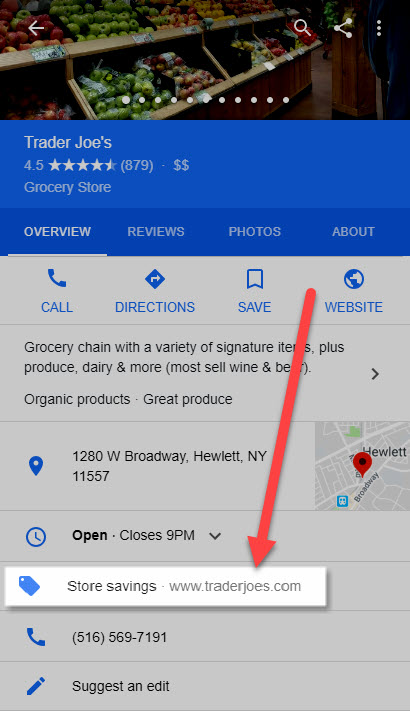
The ‘Store savings’ section of the Local Knowledge Panel
There are literally scores of other examples I could harp on, such as the ability to add a service menu to your Google business listing or the ability to showcase your full product collection via the Local Panel.
The point, however, is quite clear: Giving businesses the ability to spread their products around via the SERP creates inertia that allows for Google to monetize the business listing. Asking business owners to pay for the options within Google My Business after having offered serious product placement abilities for free puts a great deal of pressure on businesses to open their wallets. Perhaps more than anything I’ve presented above, creating a reliance on SERP features for product proliferation is surely the most effective way to create monetization buy-in on the part of business owners (no pun intended).
The Full Google Monetization Picture
It should be pretty clear at this point that Google has undertaken a highly focused local SERP feature strategy that directly leads to GMB monetization. Whether it be Google Posts, Reserve with Google, or product placement within the Local Panel, there is one common denominator… the fostering of reliance on Google’s local SERP features.
In each of the three instances I have presented, Google has created a construct that makes its local SERP features a competitive necessity. The emergence of its local features as being essential is the very element that allows for GMB monetization to succeed. Whether they like it or not, local businesses rely on their Google listings in all new ways and to far greater extents than just two years ago.
Over the past year and a half, the conversation around seemingly minor local feature elements has left us a bit bewildered. Why would Google spend so much time working on the messaging button inside the Local Panel? However, considering the path towards GMB monetization even a small change such as a more prominent messenger button makes sense. The more businesses that rely on the feature to interact with their customers, the greater the force on businesses to pay for its utilization.
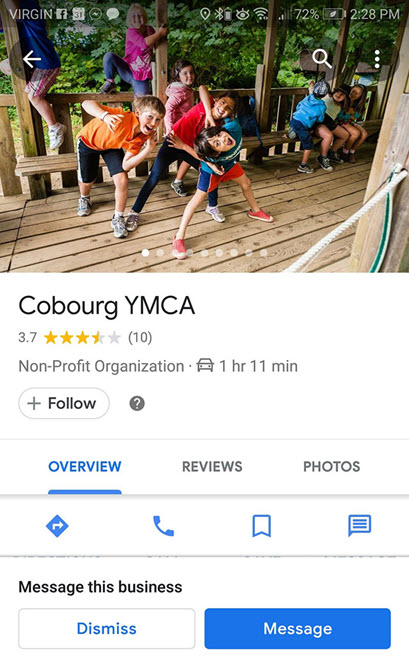
One local SERP feature test displayed a Local Knowledge Panel with a more prominent ‘message’ button (Image Source: SERoundtable)
The increasing amount of time Google has put into its local SERP features, the increasing amount of details addressed, and the increasing number of tests and updates only makes real sense when you consider it all leads to GMB monetization.
What’s Pulling Google to Monetize Google My Business?

The path Google has taken to create the potential for succeeding with a more monetized GMB aside, we still don’t know why Google has deemed this excursion necessary. Of course, you could simply say the more revenue the better. While that’s certainly true, it’s far from a refined analysis of the catalysts driving the move. For that, we again need to create a bit of context.
The Role of Ads In Google’s Quest for a Monetized Google My Business
When discussing Google revenue, the most logical place to start is with ads which drive most of Google’s earnings. Over time, ads have become far more complex for the search engine. Let’s leave aside big-ticket items such as The Guardian removing all of their YouTube ads. I’d rather focus on the larger advertising context than a few headlines.
The most notable advertising “crisis” Google has had to deal with over the past three or so years is ad blocking. Users have been waking up to the realities of the digital world at a rapid pace (hence the current privacy concern “craze”). The issue with ads, in short, is basically the notion that Google must find a balance between ad revenue and ad quality. Too many low-quality ads only fuel the platform’s poor advertising perceptions.
To this effect, Google has undertaken drastic measures that include a mobile interstitial penalty and a Chrome Ad Blocker.
The obvious catch here for Google is the reduction of ad revenue possibilities. Indeed, Google’s Q1 revenue data for 2019 (which coincidentally came out just days after the GMB monetization survey), was a cause for some alarm. While advertising clicks were up 39% that’s a huge reduction compared to Q4 of 2018 which had click growth at 66%. To make matters worse, CPC is down 19%. A slowdown in click growth coupled with a cost per click reduction produced lower than expected earnings and had Google’s stock price dropping following the release of the earnings report.
I don’t think any of the news out of Q1 was a surprise to Google. I think they’ve known this is a long time coming. I think Google has been preparing for this inevitability since the summer of 2018 when it turned its Flight Box and particularly hotel listings into a booking center juggernaut!
And sure, revenue may go back up next quarter, but I think the writing is on the wall… the current paradigm will not be as effective at generating ad revenue and a shift, such as the monetization of GMB, is needed.
Why a Paid Google My Business Platform Is Perfect for Voice Search
You could ask, why is Google focusing on GMB monetization when the monetization pink elephant is obviously voice search? Of course, you could propose all sorts of answers including the fact that Google just doesn’t have a good way to earn voice search revenue. That said, I’d like to advance the notion that a pay to play GMB is voice search monetization.
Here’s what the survey said about verified business licenses:
“Google verifies your trade license and displays your verified licenses on your Business Profile.”
Aside from the obvious benefit to this, i.e., users knowing if a business can be trusted, there is a revenue dynamic lurking below the surface.
Google already utilizes this model. They’re called Local Service Ads. Again, aside from their benefit to users, there is a revenue dynamic here… you have to pay Google to be part of the program. However, there is yet another revenue construct here – voice search.
Reports came out in early April 2019 that Google was utilizing guaranteed businesses within voice search results. The implication was that Google was fueling its voice search responses with Local Service Ad partners. Google clarified that such was not the case. However, the paradigm does present an interesting way to stimulate voice search revenue, albeit in a roundabout sort of way.
By opening up business verification, and charging for it, Google is in a position to indicate to voice search users whether or not a business has been verified. There are numerous incarnations of how this may play itself out. Just to offer one simple possibility, Google could offer organic listings and then ask the user if they would like to hear any guaranteed options should they be present. This construct would not indicate any sort of ‘pay to play foul play’ and would stimulate indirect voice search revenue.
No matter how you slice it, there is a strong correlation between local results and the world of voice search. A monetization of GMB would surely have a voice search revenue impact in some way, shape, or form.
Paying Heed to Google’s Local Library

While Google has not confirmed that it will or won’t monetize GMB, in this author’s opinion, the writing is on the wall. Google has clearly been doubling-down on creating a deeply integrated relationship between its local features and businesses. It’s a relationship that focuses on a reliance on Google’s local features. As a result, and regardless of Google’s advertising conundrums, GMB is primed, more than it ever has been, for significant monetization. One would have to think that the monetization of GMB in some way is simply inevitable.
It’s clearly worthwhile to pay close attention to the changes and even the tests Google rolls out for its local features. Personally, I think you’ll see far more incentives and opportunities for businesses to list their products within these features. Whatever it may be, it is more important than it already was to track the changes Google has made to its local features.
To this extent, I highly recommended you track the news reported on SERoundtable.com each day as well as peruse through our monthly SERP news digest.
If you see anything striking in the realm of local SERP features, reach out to me, I’m always interested in hearing from you!

